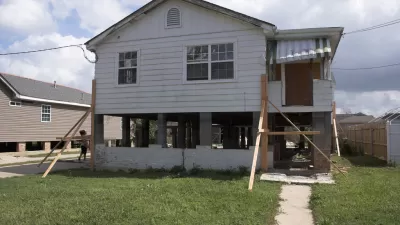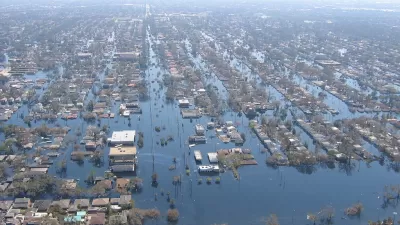Mark Byrnes explains the recent renovations - both inside and outside - of New Orleans' Superdome, home to Sunday's Super Bowl. The work was funded, at least in part, by FEMA.
The most recent images of the Superdome that many of us remember will include its use as an emergency shelter in the aftermath of Hurricane Katrina, when it became a temporary (and damaged) home to 20,000 refugees. In the years since, the building, which opened in 1975, has benefitted from more than $500 million in renovations, some of which might be noticeable in the eight hours of network television coverage this Sunday.
Perhaps the most interesting of the renovations are those that can be witnessed during the 355 days when the Saints aren't playing a game. "Perhaps the biggest change in the way people experience the stadium is through Champions Square, 60,000 square feet of new public space replacing a retail facility that struggled to come back after Katrina," explains Byrnes.
"New Orleans is built around a series of public squares," says Ellerbe Becket's Paul Griesemer, "so it was only natural we add on to that history."
"The square has also allowed the city to make the Superdome and everything around it lively when there’s no football game. Champions Square hosts concerts and local food vendors, creating a contemporary public space that fits in with the city’s traditional urban forms better than its retail predecessor. Planners hope to see a residential component added in the future. Says Griesemer: 'It’s really a story of great fortitude for everyone who wanted to bring the dome back and make sports the anchor of the city again.'"
FULL STORY: What Super Bowl Fans Can Expect From the Revamped Superdome

Alabama: Trump Terminates Settlements for Black Communities Harmed By Raw Sewage
Trump deemed the landmark civil rights agreement “illegal DEI and environmental justice policy.”

Planetizen Federal Action Tracker
A weekly monitor of how Trump’s orders and actions are impacting planners and planning in America.

The 120 Year Old Tiny Home Villages That Sheltered San Francisco’s Earthquake Refugees
More than a century ago, San Francisco mobilized to house thousands of residents displaced by the 1906 earthquake. Could their strategy offer a model for the present?

In Both Crashes and Crime, Public Transportation is Far Safer than Driving
Contrary to popular assumptions, public transportation has far lower crash and crime rates than automobile travel. For safer communities, improve and encourage transit travel.

Report: Zoning Reforms Should Complement Nashville’s Ambitious Transit Plan
Without reform, restrictive zoning codes will limit the impact of the city’s planned transit expansion and could exclude some of the residents who depend on transit the most.

Judge Orders Release of Frozen IRA, IIJA Funding
The decision is a victory for environmental groups who charged that freezing funds for critical infrastructure and disaster response programs caused “real and irreparable harm” to communities.
Urban Design for Planners 1: Software Tools
This six-course series explores essential urban design concepts using open source software and equips planners with the tools they need to participate fully in the urban design process.
Planning for Universal Design
Learn the tools for implementing Universal Design in planning regulations.
Clanton & Associates, Inc.
Jessamine County Fiscal Court
Institute for Housing and Urban Development Studies (IHS)
City of Grandview
Harvard GSD Executive Education
Toledo-Lucas County Plan Commissions
Salt Lake City
NYU Wagner Graduate School of Public Service





























